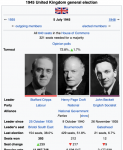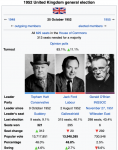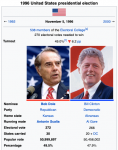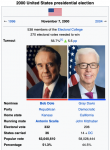"F@ck you neoliberal shitheads we're doing the universal healthcare"
WHAT IF BILL CLINTON GOVERNED LIKE A LEFTIST?
42. Bill Clinton/Al Gore (D): January 20, 1993-January 20, 1997 'The Pendulum Swings Back'
1992: def. George H.W. Bush/Dan Quayle (R), Ross Perot/James Stockdale (I); 370-168-0 EV/43.0%-37.5%-18.9% PV
Though controversial as President, public opinion of Bill Clinton (at least of his time in the White House) has evolved into a competent executive merely ahead of his time. The 1990s were a very conservative era, which makes his presence at all somewhat of an enigma. Clinton was ruthless in his fight for progressive and liberal causes, nuking the filibuster and using his immense intelligence to get more for Americans. During his first year, legislation establishing three months of paid parental leave, free community college, and a minimum wage increase of '$6 by 1996' were signed. But this was only the beginning.
Throughout 1994, the White House aggressively pushed for and got healthcare reform (seen as an 'American version of universal healthcare', or more often compared to the Swiss version), a carbon tax, and a massive investment in infrastructure passed. However, this energized conservatives, who turned out strongly for Republicans in the 1994 midterms. The 1994 elections gave the GOP 57 Senate seats (OTL along with Hawaii and California) and a solid 235 House seats.
While an improving economy and a bill restricting government shutdowns helped the President, the victory of Albert Makashov in the 1996 Russian Presidential Election and other issues allowed Republicans to cast Clinton as a closet communist plotting a takeover of a country he already ran. Clinton pulled out every single trick in the book, and the campaign bombarded TVs across the country with ads. But it wasn't enough.
Senate Majority Leader Bob Dole and Associate Justice Antonin Scalia narrowly won the 1996 Presidential Election. Clinton conceded gracefully and appointed Merrick Garland to Scalia's vacant seat before retiring to New York with the First Lady.
43. Bob Dole/Antonin Scalia (R): January 20, 1997-January 20, 2005 'Rage For The Machine'
1996: def. Bill Clinton/Al Gore (D); 272-266 EV/49.5%-47.9% PV
2000: def. Gray Davis/Barbara Lee (D); 332-206 EV/51.3%-44.5% PV
President Bob Dole took office with a significant trifecta in both Houses. But this was still a disappointment to Republicans. While many a conservative dreamed of a filibuster proof majority, a Democratic overperformance in Congress (caused by both President Clinton's redirecting of resources in his belief that he'd lose and voters wanting a check on the powers of Dole, who was viewed as almost certain to take over) meant that the GOP was stuck at 57 seats (Oregon and New Hampshire went the other way ITTL). In addition, the presence of Ben Nighthorse Campbell, Michael Huffington, Pat Saiki, Olympia Snowe, Susan Collins, Arlen Specter, John Chafee, Jim Jeffords, and John Warner meant that the filibuster wasn't going to be nuked.
Instead- much to the consternation of the right- President Dole moved ahead with what he actually could get done. The top tax rate was immediately cut from 42.5% to 37.5%, along with other deductions. Democrats filibustered any attempt to tamper with their now-popular healthcare system, so Dole decided to instead make a deal with moderates to reform social security (cutting benefits by an average of 15%) and increasing military spending and research (including a missile shield).
Because of this bipartisan popularity, the Republicans suffer minimal losses in the 1998 midterms (the only races that go the other way are Moseley-Braun and Baesler winning, giving the GOP 55 seats). A balanced budget and decreasing poverty put the President in a good spot for re-election. However, many conservatives were dissatisfied with Dole. So, Kentucky Senator Mitch McConnell announced a primary challenge. McConnell would sweep the south, but Dole would be renominated.
His popularity ensured a large victory in the general election, despite a third party bid by Pat Buchanan, and despite the Democrats gaining 3 seats in the Senate (Abraham, Huffington, and Saiki hold on). His second term began with further tax cuts (including a negative income tax for low-earners) and further action on many conservative policies. This was, of course, upended by 9/11. The collapse of the World Trade Center's south tower and the collapse of Trump Tower (which was accidentally hit) along with the attack on the Pentagon was a wake up call for the country. Dole had boots on the ground in Afghanistan within 48 hours and the Taliban overthrown within 96. With his newly-found 94% approval rating, the President signed the National Aid Act, which designated $50 Billion into rebuilding Afghanistan. The President finished his term with decent approval ratings.
44. John McCain/Elizabeth Dole (R): January 20, 2005-January 20, 2009 'Continuity Boredom'
2004: def. Barbara Lee/John Kerry (D); 279-259 EV/49.1%-47.9% PV
From the beginning, it was clear Vice President Antonin Scalia would not be running in 2004. He took nearly a hundred personal days due to poor health. Looking at the popularity of Dole, the Republicans nominated another relatively moderate, elderly war veteran in John McCain. McCain won an unexpectedly close election against Representative Barbara Lee, and entered the White House in January of 2005. It was clear from the onset the moderately conservative centrism would be continued.
But there would be an exception to that. President McCain would sign a massive overhaul of campaign finance laws, heavily restricting corporate spending and setting a limit on individual contributions. But this middle-of-the-road attitude did nothing when the financial crisis rolled around. McCain was extremely strict on bailouts, leading to the mass failures of several corporations and a spike in unemployment to 10%. Despite this, his personal popularity enabled a decent re-election defeat.
45. Al Gore/Bernie Sanders (D): January 20, 2009-January 20, 2017 'The Middle-Age Man And The Rising Sea'
2008: def. John McCain/Elizabeth Dole (R); 298-240 EV/ 49.8%-46.3% PV
2012: def. Newt Gingrich/Paul Ryan (R); 303-235 EV/ 50.7%-46.5% PV
After twelve years, the American people had again rejected the status quo. Former Vice President Al Gore was swept into office with a large mandate. Immediately the Democrats approved a $1.5 Trillion stimulus for the economy, along with an increase in the top tax rate from 36.8% to 42.5%. Gore also signed the Dodd-Frank financial regulation bill (which is even more aggressive than OTL) and raised the minimum wage from $9.75 to $14.00 by 2012.
But the crowning achievement of the President's first term was undoubtedly his massive environmental bill. The carbon pricing index was increased to $65/MT, environmental fines were increased, and the 'Net Zero By 2025' goal was implemented. Further expansion of healthcare (reducing premiums and increasing the number of Americans who didn't have to pay anything from roughly 1/4 to nearly half).
Gore was easily re-elected, and presided over an increasingly prosperous Afghanistan and an increasingly well-run America. By 2015, it was abundantly clear that the successor to Gore would be a Democrat. It was unclear who that would be. But Bernie Sanders' heart attack put the biggest frontrunner out of the running. Eventually, Barack Obama (who came in second in 2008) won the nomination and coasted to victory in the general. Gore retired to Tennessee with a high approval rating.
46. Barack Obama/Tom Steyer (D): January 20, 2017-May 2, 2020 'Biting The Bullet Of Change'
2016: def. Paul Ryan/Sarah Palin (R); 347-191 EV/ 50.2%-45.1% PV
Most often a great leader is succeeded by someone less successful. Bush, Major, and others come to mind. But other times said leader is outshown by one that is truly once in a generation great. Barack Obama fits into the latter category. Assuming office on January 20, 2017, the nation's first Black chief executive was immediately faced with a crisis.
North Korea threw around nuclear threats all the time, but their launching of a missile that blew up only a few miles off the coast of Japan was the last straw. President Obama immediately entered diplomatic negotiations, which proved futile. The White House had Tomahawks launched and impacting key weapons sites within two hours.
Then the Chinese intervened. President Xi Jinping immediately deployed Chinese forces into the rogue state. The country stared down the barrel of another Cuban Missile Crisis. Until the President intervened. President Obama won a diplomatic victory for the US, which boosted his popularity. He also passed several popular policies, including an extremely high-quality universal school meal program and making community college tuition free.
The Democrats were rewarded with an expanded majority in the midterms. Obama signed legislation reducing the top tax rate from 42.5% to 40.0%, in exchange for the implementation of a 'two cent tax' on billionaires. The COVID pandemic (slightly more deadly than OTL) caught everyone by surprise, but the White House sprang into action. A nationwide lockdown was implemented beginning in early March, while the borders were closed. President Obama's approval ratings torched 85% as the rest of the world buckled.
Unfortunately, some people were mad about the lockdowns. A dissatisfied former veteran took the initiative and sniped the President from long-range as he descended from the steps of Air Force One. President Obama was immediately moved to the Margaret Craighill Armed Forces Hospital (Basically the new Walter Reed but renamed). Only the hospital's status as indisputably the best in the world (President Gore threw $1.5 Trillion over several years at the VA, so this of course was inevitable) prevented the President from dying. Still, he was clearly not well enough to be President. He announced his resignation on June 9, 2020, propelling Tom Steyer to the White House.
47. Tom Steyer/VACANT (D): May 2, 2020-June 11, 2020
47. Tom Steyer/Joe Biden (D): June 11, 2020-January 20, 2021
47. Tom Steyer/Kamala Harris (D): January 20, 2021-Present 'Dr. Thomas Fahr Steyer PhD HRES, Populist Hero'
2020: def. Ted Cruz/Tina Forte (R); 425-113 EV/ 57.2%-39.8% PV
Tom Steyer's career is perhaps one of the most interesting of anyone to occupy the Oval Office. What is clear, however, is that he was a highly successful Governor of California who was picked by then-Senator Obama for racial and political balance. In that regard, they succeeded- a progressive billionaire white guy with experience in the executive branch and a more moderate black man from the midwest with legislative experience- and the Obama/Steyer ticket coasted to November.
President Steyer handled COVID just as well as his predecessor, and cruzed (haha get it?) to victory in the general election against a ticket that included Texas Senator Ted Cruz and raving-lunatic-who-won-a-special-election-in-New-York-and-was-a-Congresswoman-for-five-months Tina Forte. He begins his second term with an overwhelming mandate.
PRESIDENTIAL RANKINGS:
Bill Clinton (1993-1997), #14/47
Bob Dole (1997-2005), #17/47
John McCain (2005-2009), #39/47
Al Gore (2009-2017), #8/47
Barack Obama (2017-2020), #4/47
Tom Steyer (2020-Present), #11/47





















